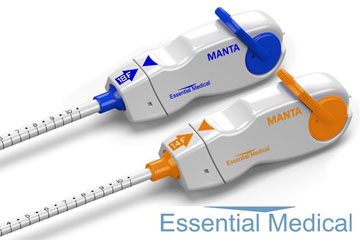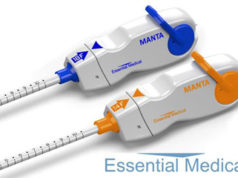
Essential Medical announced on 8 July 2016 that it has received investigational device exemption (IDE) approval from the FDA to begin the US clinical trial for Manta, the company’s large bore vascular closure device.
The pivotal study will evaluate the safety and efficacy of vascular access closure using Manta for femoral arterial access sites in patients undergoing percutaneous procedures using sheaths ranging from 10F to 24F. Manta will be used to achieve safe, percutaneous closure in a variety of large bore procedures including transfemoral transcatheter aortic valve implantation (TAVI), endovascular repair of abdominal aortic aneurysms (EVAR), ventricular assist devices, and balloon aortic valvuloplasty.
According to Essential Medical, these large bore procedures are the fastest growing segment of the cardiovascular market and are driving a worldwide market for large bore vascular closure devices to exceed US$600 million within the next five years. Closure of large bore femoral access sites has been associated with significant increases in morbidity including longer times to achieve haemostasis, extended procedure time, higher rate of complications, and higher total cost of care. Manta was specifically designed to address these complexities of closing large punctures in high-pressure vessels utilising novel closure technology.
Manta’s simple and fail-safe deployment provides immediate haemostasis in order to reduce the complications and cost associated with large bore closure.
David Wood, co-principal investigator of the US MANTA trial and a founding member of the Centre for Heart Valve Innovation in Vancouver, Canada, stated “We are constantly seeking a safer and more efficient way to replace a patient’s failing heart valve, which is why our ongoing Multidisciplinary, Multimodality, but Minimalist (3M) TAVR Trial is so important. While transfemoral TAVI has advanced rapidly and can now be safely performed in fully awake patients in less than 30 minutes, the vascular closure method for these cases has not progressed and access site related complications remain a concern. Safe, reproducible percutaneous large bore closure is needed before transfemoral TAVI can become the default strategy in most patients.”
Zvonimir Krajcer, co-principal investigator of the US MANTA trial and co-director, Peripheral Vascular Disease Service at the Texas Heart Institute in Houston, USA, commented “I am very excited to be a part of the MANTA vascular closure trial as I believe it will deliver fewer complications and faster overall procedure times based on the EU data. Until now for EVAR and TEVAR we had to use the vascular closure devices that were not originally designed for this indication. Finally, for the first time with MANTA we will have the opportunity to use a reliable and simple vascular closure device for large bore sheaths. This device will in a safer way advance the treatment of many patients with aortic aneurysmal and valvular heart disease.”












